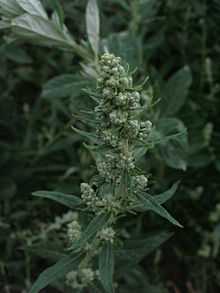Artemisia douglasiana
| Artemisia douglasiana | |
|---|---|
 | |
| Scientific classification | |
| Kingdom: | Plantae |
| (unranked): | Angiosperms |
| (unranked): | Eudicots |
| (unranked): | Asterids |
| Order: | Asterales |
| Family: | Asteraceae |
| Genus: | Artemisia |
| Species: | A. douglasiana |
| Binomial name | |
| Artemisia douglasiana Besser | |
Artemisia douglasiana (California Mugwort, Douglas's Sagewort or Dream Plant) is an aromatic herb in the genus Artemisia. It is native to western North America, in the Western United States and into Baja California, Mexico.
Its leaves have been shown to contain Thujone, which is suspected to have mild psychoactive properties, and Cineole, which is an antibacterial agent.[1]
Description
A. douglasiana is dicot, and a perennial forb. Its stems grow erect and range in height from .5-2.5 meters.[2] During its bloom period which ranges from May to October A. douglasiana features bell-shaped clusters of flowers containing 5-9 pistillate flowers and 6-25 disk flowers.[2] Its grey-green leaves are evenly spaced, elliptical, and lobed at the tips.[2] The appearance of the 3-5 lobes at the tips of its leaves may range from being seemingly absent to being highly defined. Its stems grow from a substantial colony of rhizomes which require a minimum soil depth of 16 cm and can grow in fine to coarse soils.[3] Although A. douglasiana can reproduce from seed it's primarily propagated from division and spreading of its underground rhizomes.
Distribution
Artemisia douglasiana is native to the western US states of California, Oregon, Washington, Nevada and Idaho, and is confined to western North America. A. douglasiana prefers direct sunlight and moist soils, but tolerates shady areas and dry soils. It occupies hardiness zones 6a to 10b and occurs at elevations ranging from 0-3080 meters.[3] A. douglasiana is often found in drainages.
Ecology
A. douglasiana's extensive rhizomes help prevent erosion by stabilizing streambanks. Its seeds are foraged by a variety of native birds and its leaves are used as nesting material by some native bees.[3] A. douglasiana is susceptible to infection by Xylella fastidiosa which causes Pierce's disease.[3]
Uses
A. douglasiana was used by native American tribes to relieve joint pain and headaches, and to treat abrasions and rashes (including poison ivy). It was also used to treat women's reproductive issues, including irregular menstruation and was occasionally used as an abortifacient.
This plant also had ceremonial and spiritual purposes for many tribes. It was commonly carried to ward off spirits of the dead and was smoked or drunk as a tea to induce vivid dreams.[1][4][5]
This plant is often planted by modern herbalists for both medicinal and spiritual uses.
References
- ↑ 1.0 1.1 "Information About California Mugwort". Indigenous Knowledge Project.
- ↑ 2.0 2.1 2.2 "A. douglasiana". Jepson eFlora. UC Berkeley. 2013. Retrieved 20 August 2014.
- ↑ 3.0 3.1 3.2 3.3 "A. douglasiana: Plant Characteristics and Associations". Calflora. Retrieved 20 August 2014.
- ↑ "Native American Uses of California Plants: Ethnobotany". University of California, Santa Cruz Arboretum.
- ↑ Hunn, Eugene S. (1990). Nch'i-Wana, "The Big River": Mid-Columbia Indians and Their Land. University of Washington Press. p. 352. ISBN 0-295-97119-3.
External links
- CalFlora Database: Artemisia douglasiana (California Mugwort)
- USDA Plants Profile: Artemisia douglasiana (California mugwort)
- Jepson Manual Treatment — 'Artemisia douglasiana
- Univ of Michigan-Dearborn: Ethnobotany of California mugwort
| Wikimedia Commons has media related to Artemisia douglasiana. |